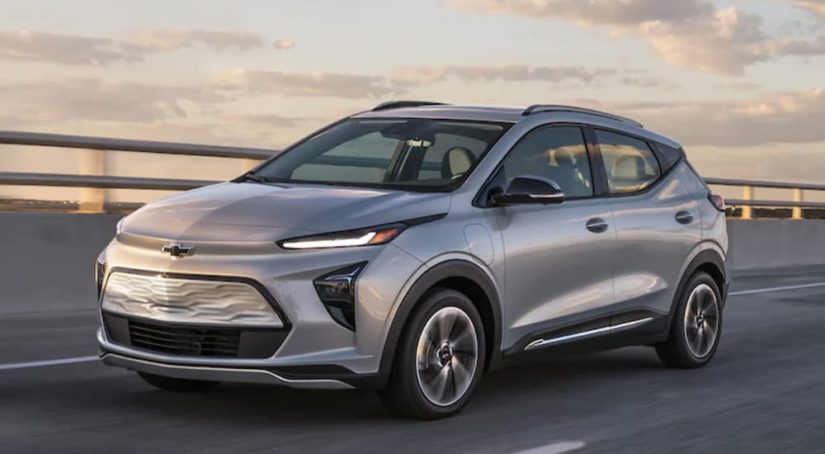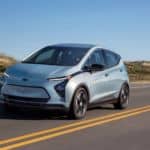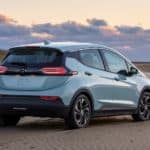In a time when automakers are scrambling to add low production hybrid and all-electric models to their fleets, the engineering team at General Motors has been hard at work producing an EV crossover for the mass market. At first glance, that may not seem like very big news, but the upcoming 2022 Chevy Bolt EUV represents a major turning point in the all-electric car market and a big gamble by General Motors.
The Bolt EUV is poised to change everything because GM intends to sell a lot of them. This tells us a few important things: first, they’re investing a substantial amount of money and factory time in electric vehicle (EV) production. Second, their dealer base is completely on board. Third, because Chevy priced the Bolt EUV within reach of mainstream car buyers, they expect the mainstream market to embrace it.
Unlike Tesla models or even some other manufacturers’ EV lineups, the Bolt EUV is positioned to appeal to buyers in one of the most competitive – and popular – categories: the small SUV segment. Consider this: Nearly 2 million small SUVs were sold in 2020. By contrast, EV sales (regardless of body style) totaled just 296,000. How is this significant?
Looking at the numbers comparatively, the industry saw a 43% increase in global electric car sales in 2020, a year when traditional gas-powered vehicle sales trended downward. The spike in EV sales was partially driven by new legislation requiring automakers to meet stringent emissions targets (which means they’re spending more advertising dollars on EVs), but it’s not just the result of top-down dictates.
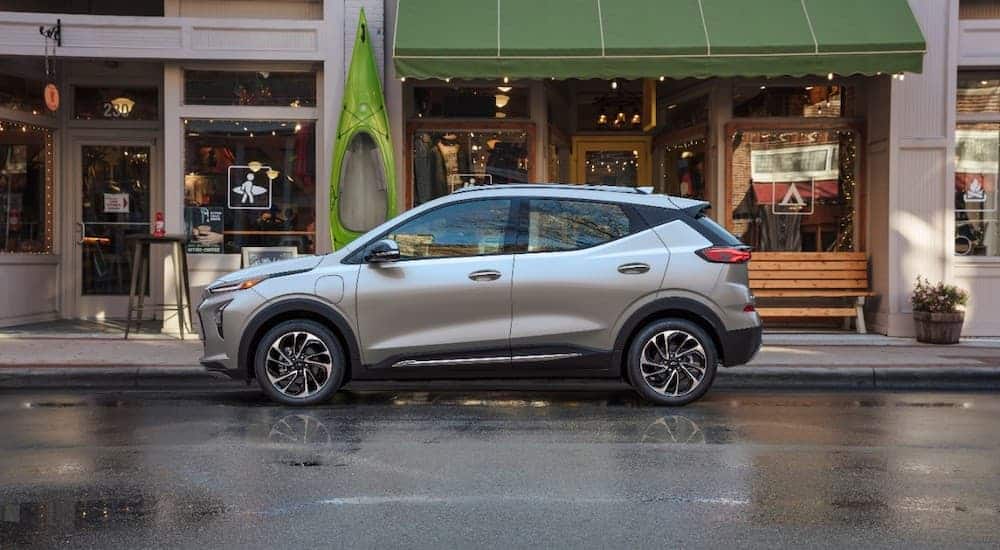
As EV prices continue to go down and battery technology improves, more buyers are considering abandoning gas-powered cars for good. If you’re one of those buyers, you might find the 2022 Chevy Bolt EUV backstory interesting, especially if you still have doubts about buying an electric car. This little SUV is a significant step forward towards General Motors’ goal of building only EVs. Achieving it means winning mass-market buyers over to EV technology.
GM isn’t hedging its bets with the 2022 Bolt EUV. The new model contains the best and most advanced battery technology on the planet, a confidence-building attribute that should help buyers overcome the usual driving range and time-to-charge objections. Manufacturing efficiencies are already driving down costs, so price is also addressed with the Bolt EUV. While it’s comforting to know that the world’s largest automaker won’t gamble on releasing a subpar-quality EV at this stage of the game, it’s also helpful to know more about how the Chevy Bolt EUV evolved and why the automaker chose the 2022 model year to launch it.
The EV Evolution
The shift to building all-electric vehicles is inevitable and not entirely driven by innovation. Automakers are feeling the pressure from the Federal and state governments to reduce carbon emissions, but General Motors’ recent announcement that it will transition to building only EVs within the next decade still sent shock waves through the industry.
The 2022 Bolt EUV is an incredibly significant first step toward that goal for GM. Pricing says it all because the Bolt EUV starts at a surprisingly affordable $33,995. This is not a stripped-down entry-level version, either. The Bolt EUV LT includes several standard comfort and luxury features, along with DC Fast Charging capability, an important feature to calm buyers’ fears about charging time.
How did the Bolt EUV evolve, and why did Chevrolet go with an SUV body style? First, a look back at GM’s EV commitment. In a November 2020 press release, the company announced its plans to release 30 new EVs globally by 2025, representing 40 percent of the vehicles it manufactures. For the first time ever, GM plans to invest more R&D dollars in EV technology ($27 billion to be exact) than in gas and diesel product development combined.
To win mainstream buyers, automakers must overcome two common objections: driving range and cost. General Motors has an answer for both. The company has pledged to reduce the cost of building its Ultium battery packs by 60 percent as soon as 2025. Also, the company expects to improve driving range to around 450 miles on a single charge. Launching the 2022 Chevy Bolt EUV is step one, and it’s a critical measuring stick. Will buyers fall in love with EVs? Are they ready to trust battery technology over tried-and-true gas engines? We think the answer to both questions is (or should be) yes.
The 2022 Bolt EUV is Affordable
The Bolt EUV is powered by GM’s Ultium battery technology. This technology encompasses hundreds of patents and is made up of low-cost, scalable (layer-able) battery packs that can produce impressive horsepower and torque. Ultium batteries are more lightweight than previous generation batteries, so the vehicles they power are lighter, more agile, and easier to drive.
The Bolt EUV benefits from GM’s achievements in manufacturing economies. It’s less expensive to build, so the price tag is lower. GM expects to continue finding less expensive ways to manufacture its Ultium batteries, so buyers can expect EV pricing to continue trending down, eventually mirroring gas-powered vehicle price tags.
The Bolt EUV starts at just $33,995, making it the first competitively-priced EV in Chevrolet’s fleet. Even the sold-out top-of-the-line Bolt EUV Launch Edition is affordable, at $43,495. All Bolt EUV trims come with standard DC Fast Charging capability, which means they can charge up to 100 miles of range in just 30 minutes.
The Bolt EUV Contains Advanced Technology
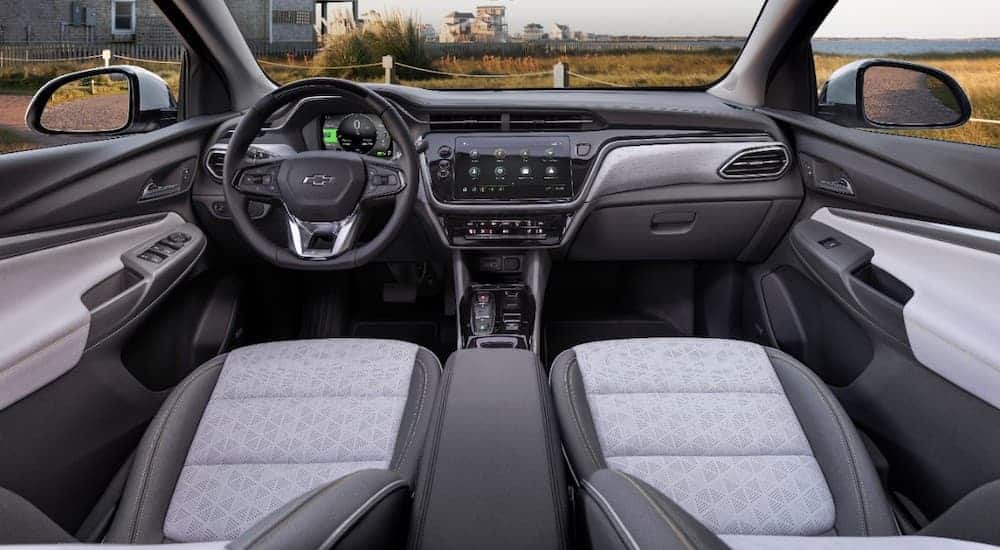
One of the most exciting announcements coming out of the Bolt EUV’s long, somewhat drawn-out pre-production release is the vehicle can be equipped with Super Cruise. Previously only available on select Cadillac models, Super Cruise is a hands-free driving assistance technology that lets drivers opt to travel at highway speeds without manually managing steering.
How does it work? The system works along designated highways using a sophisticated combination of GPS, sensors, and LIDAR mapping technology to center the vehicle within its intended lane, eliminating the need for drivers to control the wheel manually. Adaptive cruise control simultaneously senses the distance of the vehicle traveling ahead and adjusts the speed as needed to maintain a safe traveling distance.
It sounds like a novelty, but Cadillac reports that their owner base has recorded over 7 million hands-free and incident-free, miles driven. With over 200,000 miles of compatible roadways in the U.S. and Canada, there’s plenty of asphalt to practice on, and the latest version of Super Cruise is even capable of making a single lane change on its own (but isn’t yet available on the Bolt EUV).
Super Cruise is part of GM’s connected services, a subscription-based plan that keeps the vehicle’s maps updated in real-time. Bolt EUV buyers will receive three years of Super Cruise over-the-air updates for free, after which time a subscription is necessary. Super Cruise is poised to reinvent the road trip, especially when combined with the Bolt EUV’s impressive 250-mile driving range.
A New World of Driving
It’s an incredibly exciting time in the automotive industry. Driverless technology and all-electric powertrains are still in their infancy, but even with that, innovation abounds. Undergirding all of General Motors’ lofty goals is its Ultium battery technology and global flexible platform strategy. Together, these two components promise to deliver manufacturing economies that will help the company drive EV prices down and infuse these vehicles with characteristics that eliminate traditional EV objections. We predict that everyone will be behind the wheel of an EV within the next few decades. Until then, who’s ready to raise their hand and be one of the first?
